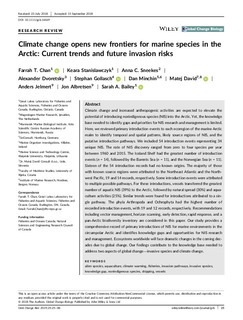| dc.description.abstract | Climate change and increased anthropogenic activities are expected to elevate the potential of introducing nonindigenous species (NIS) into the Arctic. Yet, the knowledge base needed to identify gaps and priorities for NIS research and management is limited. Here, we reviewed primary introduction events to each ecoregion of the marine Arctic realm to identify temporal and spatial patterns, likely source regions of NIS, and the putative introduction pathways. We included 54 introduction events representing 34 unique NIS. The rate of NIS discovery ranged from zero to four species per year between 1960 and 2015. The Iceland Shelf had the greatest number of introduction events (n = 14), followed by the Barents Sea (n = 11), and the Norwegian Sea (n = 11). Sixteen of the 54 introduction records had no known origins. The majority of those with known source regions were attributed to the Northeast Atlantic and the Northwest Pacific, 19 and 14 records, respectively. Some introduction events were attributed to multiple possible pathways. For these introductions, vessels transferred the greatest number of aquatic NIS (39%) to the Arctic, followed by natural spread (30%) and aquaculture activities (25%). Similar trends were found for introductions attributed to a single pathway. The phyla Arthropoda and Ochrophyta had the highest number of recorded introduction events, with 19 and 12 records, respectively. Recommendations including vector management, horizon scanning, early detection, rapid response, and a pan‐Arctic biodiversity inventory are considered in this paper. Our study provides a comprehensive record of primary introductions of NIS for marine environments in the circumpolar Arctic and identifies knowledge gaps and opportunities for NIS research and management. Ecosystems worldwide will face dramatic changes in the coming decades due to global change. Our findings contribute to the knowledge base needed to address two aspects of global change—invasive species and climate change. | nb_NO |
